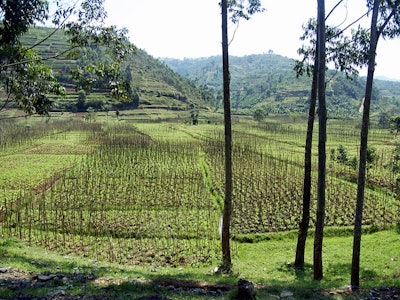
Despite its location near the equator, Rwanda’s temperate climate and a rainy season that coincides with farm harvests mean that the country’s corn and peanut crops are likely susceptible to mycotoxins.
In particular, there is concern that Rwandan corn might be susceptible to aflatoxins and fumonisins, toxins in moldy corn that can cause health problems for both humans and animals. But it’s hard to say whether levels of mycotoxins in Rwanda — a country of nearly 12 million people in central Africa, of which 80% are involved in agriculture — are high enough to be dangerous because no one has ever really measured them thoroughly.
That will change this year, however, as researchers from Iowa State University start a yearlong project to collect and analyze about 3,000 samples across the country to assess the potential risk and develop solutions for everyone from the government down to individual farmers.
The project is part of the United States Agency for International Development’s (USAID) Feed the Future Innovation Lab for Livestock Systems run out of the University of Florida. The lab awards grants for projects that “enhance the production, marketing and consumption of animal-source foods (ASF) in the target countries in order to increase the incomes, livelihoods, nutrition and health of households, especially those of vulnerable women and children.” Dirk Maier, Iowa State grain handling and storage specialist, professor and principal investigator on the project, and Erin Bowers, mycotoxin sampling and analysis specialist and post-doctorate research associate, are leading the research work with doctoral student Kizito Nishimwe, who is from Rwanda.
“There hasn’t really been any comprehensive studies with samples collected over the scope of the grain’s value chain,” Maier said.
Dairy and poultry are significant to the diets of Rwandan people, so keeping those animals healthy is important, Maier says.
“They have a very rapidly growing demand for animal-sourced protein, and the feed industry has been growing by trying to respond to those opportunities,” Maier says. “Just a few years ago, there was only one commercial feed mill company in the country. Today, there are seven in operation.”
Not knowing the mycotoxin levels on Rwandan farms means it’s difficult to know how animal health is affected or how farming practices in the country could be feeding the potential problem.
“There have been some countries that have had more advancement in this area, like Kenya, Tanzania and Uganda, but some of the smaller countries and those that have fewer resources haven’t had the funds to do the work to establish a baseline level of these mycotoxins,” Bowers said. “This is a project to improve food and feed safety that will hopefully impact the livelihoods of people in the country, to help them identify if there is an issue, and if so, to help support the mitigation of that issue.”
The case of Rwanda
Without baseline measures, the Iowa State researchers can’t say for sure that mycotoxins are a significant problem in Rwanda, but it’s likely they are.
Rwanda is located near the equator, but since much of the country is covered with hills and mountains, temperatures are less tropical and more temperate. Much of corn’s growth occurs during the country’s dry season from June to September. But there is also an extended rainy season during one of the harvesttimes, from October through November.
Aflatoxin, one of the more significant risks in corn, is a secondary byproduct of some Aspergillus fungal species, and tends to be a problem in drought-stressed crops that are exposed to high humidity or wet conditions before harvest and during storage. Rwanda’s dry-wet season combination makes conditions ripe for the toxin.
Fumonisins are secondary by-products of some Fusarium fungal species and are one of the most widely present mycotoxins in corn around the world. Like aflatoxins, they are usually a problem in corn that has had significantly dry conditions followed by wet weather during silking, much like what is seen in Rwanda. Fumonisins are also often associated with grain damaged by insect infestations.
“Conditions would be good for mycotoxins in Rwanda, and neighboring countries have reported issues. We’re suspecting that this may also be the case in Rwanda,” Bowers said.
The climatic conditions mimic those of the Southeastern United States and other areas of the country, Maier said, which gives researchers some idea what they might find when sampling and analyzing grain in Rwanda.
“Certain growing conditions are not different than those seen in large parts of Texas, which also has aflatoxins issues in corn and peanuts,” Maier said.
Health impacts
With an economy and people so dependent on animal agriculture, mycotoxins are a significant concern. Many of the toxins can have serious health implications for animals and humans at high enough levels.
In the U.S. and many more industrialized markets, there is a difference between the corn used for human and animal consumption. That’s not the case in Rwanda, however.
“If we’re sampling feed and ingredients, and we’re sampling corn, they don’t have a differentiated market,” Bowers says. “If the animals don’t eat it, the humans eat it. If the humans don’t eat it, the animals eat it.”
For people, aflatoxins and fumonisins have been linked to a number of diseases and other health problems, some of which there is evidence of in Rwanda already.
“Mycotoxins are certainly a presence and concern, and a huge exposure to mycotoxins, particularly aflatoxin, has significant consequences including growth stunting and liver cancer, as well as issues with animals, including feed refusal,” Maier said.
Aflatoxin is a potent liver carcinogen, and fumonisin can cause neural tube defects and is thought to be connected to esophageal cancer.
Animals are more susceptible to the effects of mycotoxins. Nishimwe says farmers who can see that grain is moldy, a sign of mycotoxin infection, might not eat it.
“They have seen moldy corn but don’t know the consequences,” he says. “They might say, ‘I won’t eat that, but I might give it to my cow.’”
That suggests animals, in some cases, may get significant doses of mycotoxins.
In addition to refusal to feed, aflatoxin can affect livestock reproduction and suppress immune systems, making animals susceptible to infectious diseases. Fumonisins are thought to cause pulmonary edema, an accumulation of excess fluid in the lungs, in swine.
Aflatoxins are also known to contaminate the milk of dairy cows, which could then be passed along to consumers of the milk.
In the U.S., allowable aflatoxinlevels in feed differ between dairy cows vs. beef cows for that reason.
It’s also possible, the researchers say, that grain contamination could damage export opportunities.
Testing and solutions
The time and cost to analyze more than 3,000 samples from locations all over the country has always been a challenge for a project like this. Dirt roads can be a special challenge in the rainy season when they turn to mud as samples need to be collected.
But lateral flow and ELISA tests have become cheaper and will allow for many more tests than might have been possible just a few years ago. Iowa State is helping set up and equip a lab at the University of Rwanda School of Food Science and Technology where scientists will not only analyze samples, but students and staff will be trained and concepts will be included in food safety courses so that they can continue this type of work long after the USAID project is complete.
In addition, researchers will survey farmers to determine whether certain practices may be increasing or decreasing the incidences of mycotoxin contamination.
“We are hoping we will be able to look at surveys to see if that gives us some insight in areas where there are mycotoxin issues, what are people doing and if there are any mitigation strategies we can employ,” Bowers says.
Based on results, the researchers will work from the top down to discuss how government might structure effective, enforceable regulations for mycotoxins and educate farmers on ways to keep their grains and animals safe and healthy.
“Education is a significant project component,” Bowers says. “Even just telling the farmers, this is what mycotoxins are, it is an issue, and here is what you can do for yourself or your animals.”
Bowers envisions working with farmers to develop good management practices, encouraging solar and biomass dryers that can reduce the effects of wet weather on grains and identifying safe ways to store grains away from pests after harvest.
Despite the short project time, Maier is hopeful that the research and training will have a lasting effect.
“We know what some of these best practices are, and we’re already producing training materials,” Maier said. “But it’s an evolutionary process from the bottom up that engages Rwandan scientists and farmers, and the government through the Rwanda Agriculture Board as partners so they then take the lead of doing this type of work in their own country.”

















